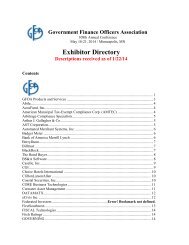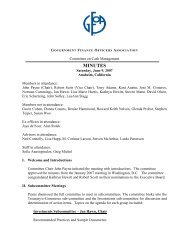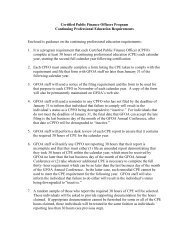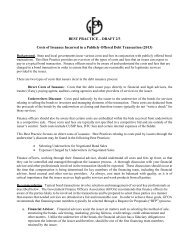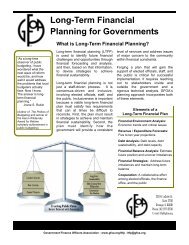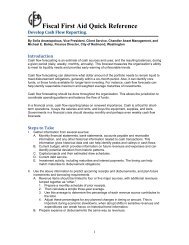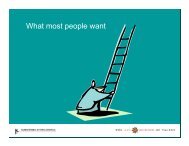MANAGING FOR INNOVATION IN LOCAL GOVERNMENT
MANAGING FOR INNOVATION IN LOCAL GOVERNMENT
MANAGING FOR INNOVATION IN LOCAL GOVERNMENT
You also want an ePaper? Increase the reach of your titles
YUMPU automatically turns print PDFs into web optimized ePapers that Google loves.
<strong>MANAG<strong>IN</strong>G</strong><br />
<strong>FOR</strong><br />
<strong><strong>IN</strong>NOVATION</strong><br />
<strong>IN</strong> <strong>LOCAL</strong><br />
<strong>GOVERNMENT</strong><br />
Three Core<br />
Strategic<br />
Factors<br />
BY GERALD T. GABRIS, KIMBERLY NELSON,AND CURTIS H.WOOD
Attempting to replicate an innovation in your<br />
finance system because it ostensibly works elsewhere<br />
might be less important than creating an<br />
environment within your management system that consistently<br />
encourages and reinforces innovative thinking.Based<br />
on a growing body of empirical research and theory, three<br />
strategic factors appear to be crucial for enhancing the<br />
innovation management capacity of local government:<br />
leadership credibility, team management, and a well-functioning<br />
governing board. Evidence indicates that local governments<br />
that practice and emphasize these factors within<br />
their administrative systems experience a significant frequency<br />
of innovations that are perceived as highly effective<br />
(“innovation”is the introduction of something new or different<br />
with the intent of maintaining or increasing system<br />
effectiveness).<br />
LEADERSHIP CREDIBILITY<br />
The subject of leadership has<br />
received considerable attention<br />
within the public sector in recent<br />
years. One theory that appears to<br />
possess ample research support and<br />
clarity is the leadership credibility<br />
model. This model, originally developed<br />
by James Kouzes and Barry<br />
Posner in their book, The Leadership<br />
Challenge, 1 stresses that leadership skills and behaviors can<br />
be learned, practiced, and used to improve organizational<br />
performance. Leaders can transform their organizations if<br />
they achieve a high level of credibility with their followers.<br />
How is this done? Leaders establish a vision of where they<br />
wish to go and then communicate that vision to followers in<br />
a way that uplifts and motivates,causing followers to accept<br />
and embrace the vision as their own. Leaders continuously<br />
strive to increase trust between themselves and their followers<br />
by making themselves vulnerable to risks and by delegating<br />
power to followers who are responsible for specific<br />
work objectives. Leaders also practice what they preach<br />
and model the way for others — in short, they take ownership<br />
of their behavior and live by the same rules and values<br />
they expect of others.Finally,credible leaders openly recognize<br />
the high performance of others and celebrate their<br />
accomplishments.<br />
If we want more frequent and<br />
effective innovations, we need<br />
to transform our bureaucraticdominant<br />
structures into more<br />
flexible and adaptive team designs.<br />
Leaders who master these skills and behaviors become<br />
leaders of integrity, honesty, trustworthiness, and believability.Followers<br />
believe in such leaders and accept their visions<br />
for change and innovation.This is crucial for innovation to<br />
really work and become accepted by the rank and file of a<br />
local government organization. Fundamentally, the senior<br />
managers (e.g., city managers, city administrators, and<br />
department heads) need to possess high leadership credibility<br />
if they want others to openly embrace change and<br />
innovation. Why, for example, should employees accept<br />
some new innovation, especially if it might involve more<br />
work and risk for them, when the finance director has low<br />
leadership credibility?<br />
The leadership credibility characteristics of senior managers<br />
can be measured and assessed through survey instruments,and<br />
managers can learn where they might have specific<br />
leadership deficiencies that lower their overall credibility.<br />
Managers can also learn how<br />
to improve their credibility through<br />
training. Increasing leadership credibility<br />
is a win-win situation for the<br />
organization and its leaders.<br />
Innovations recommended by senior<br />
managers actually become<br />
accepted and practiced by followers<br />
in a meaningful way, and thus flow<br />
down the hierarchy and become<br />
part of the organization’s culture and operations.And managers<br />
receive positive reinforcement by knowing that their<br />
attempt to bring change to the system has been effective.<br />
TEAM MANAGEMENT<br />
Even before In Search of Excellence 2 became a national<br />
best seller in the 1980s, the idea that organizations using a<br />
team approach to management were often more productive<br />
than those structured along strict bureaucratic lines<br />
was an accepted principle in organization development.<br />
Highly respected organization theorists have made a strong<br />
case for the team model, 3 and more recent work further<br />
reinforces these earlier arguments and findings. 4 But what is<br />
team management, and how does it improve innovation?<br />
To begin, one must realize that most local governments<br />
are structured bureaucratically. Authority is hierarchical,<br />
December 2009 | Government Finance Review 23
with those at the top having the most power and those at<br />
the bottom having the least, and work is divided into specialized<br />
functional units. While bureaucratic design has<br />
many benefits and positive attributes (e.g.,efficiency,rational<br />
decision making, and work specialization), it also has<br />
many problems and dysfunctions. Vertical and horizontal<br />
communications within bureaucratic systems are often<br />
convoluted and slow, and specialized units often compete<br />
for resources and recognition.Employees performing repetitive<br />
work can become bored and unmotivated, and they<br />
often find upward promotion opportunities limited.<br />
Generally, lower ranking employees want certainty and stability<br />
in their jobs and tend to resist change.When change<br />
is needed, senior managers have a hard time pushing<br />
change down through the hierarchy in a way that is accepted<br />
by these workers.And when change is implemented by<br />
rank-and-file employees, they tend to re-interpret the innovation<br />
in a way that conforms to existing habits,techniques,<br />
and practices. Consequently, bureaucratic organizations<br />
tend to be unfriendly toward innovation.<br />
The team management approach<br />
provides a solution to these antiinnovation<br />
bureaucratic tendencies.<br />
A team can be defined as a carefully<br />
designed work group whose<br />
members must rely on intensive collaboration<br />
if the work group is to<br />
experience success in achieving its<br />
specified objective.While not all work in local government<br />
lends itself to a team management approach,most tasks are<br />
achieved by teams rather than by individual employees<br />
doing their own thing.Teams work because a collection of<br />
employees working together on services, innovations, problems,<br />
and puzzles can use their combined brainpower in a<br />
context that generates better and more varied solutions<br />
than most individuals acting alone. Well-designed work<br />
teams tend to possess the following qualities: open and frequent<br />
communications, complementary expertise, clear<br />
sense of purpose and goals, trust and respect among members,a<br />
clear sense of roles for members,a lack of hierarchy<br />
and positional authority (everyone is more or less equal),a<br />
willingness to think outside the box, a belief in accomplishment<br />
and doing better than average,and a willingness<br />
to disagree with other team members.<br />
Strong management teams have<br />
the capacity to customize innovations<br />
to better fit specific departmental<br />
needs and practices.<br />
When local governments use team management, especially<br />
at the senior management level, many of the problems<br />
and pitfalls associated with innovations can be<br />
thought through and resolved before they turn into serious<br />
impediments to implementation. Moreover, when an innovation<br />
is designed by a team, the members of the team<br />
assume ownership of the innovation and have a higher<br />
stake in making sure it is effective.The team will more likely<br />
make adjustments and corrections to an innovation if it<br />
is experiencing problems without feeling threatened by<br />
such occasions as a mark of failure. In fact, mistakes<br />
become learning moments that enable the organization to<br />
grow and adjust in how it carries out its mission.<br />
As with leadership credibility, the level of team management<br />
within a local government can be measured and<br />
assessed through a variety of instruments. We can assess<br />
where management may be deficient in using a team<br />
approach and make specific recommendations on how to<br />
improve its team management. In fact, there is a broad literature<br />
and practice in organization<br />
development specifically focused<br />
on team building that can be used to<br />
improve team operations in just<br />
about any local government situation.<br />
Hence, if we want more frequent<br />
and effective innovations, we<br />
need to transform our bureaucraticdominant<br />
structures into more flexible<br />
and adaptive team designs.<br />
Governing Board Functioning<br />
The third and final factor in the managing-for-innovation<br />
troika involves the municipal governing board (or city<br />
council).While governing boards do not initiate many technical<br />
innovations, they play an important role regarding<br />
approval and support.When a local government engages in<br />
strategic planning, the governing board is a crucial partner<br />
with professional management in making sure that a strategic<br />
plan is approved in principle, and that it actually gets<br />
implemented and funded. Governing boards in public<br />
organizations formulate and legitimize policy decisions,<br />
with substantial input and help from professional staff.The<br />
board and staff need to work together smoothly within a<br />
framework of mutual respect and trust. When governing<br />
24 Government Finance Review | December 2009
oards become dysfunctional,professional staff is often put<br />
into a defensive routine where frequent and effective innovations<br />
become difficult to pursue. This is because advocating<br />
change to dysfunctional boards involves high risk —<br />
staff members may be challenged or even attacked for suggesting<br />
something new.What,then,are the characteristics of<br />
a functional governing board?<br />
Functional governing boards tend to share characteristics.They<br />
make decisions by consensus.They compromise<br />
and find win-win solutions. Majority-rule decisions may be<br />
needed occasionally, but these tend to create win-lose outcomes,<br />
with the losers seeking revenge at a later time.<br />
Highly dysfunctional boards are characterized by conflict<br />
between members,exemplified by stalemate and recurring<br />
factionalism.Functional boards seek solutions for the good<br />
of the whole and speak as one, with the board chair or<br />
mayor acting as facilitator. Dysfunctional boards include<br />
mavericks who always disagree with the majority and who<br />
attack the staff, disrespect colleagues, and focus mainly on<br />
narrow issues. Functional boards display mutual respect,<br />
follow their own rules, and tolerate disagreement without<br />
allowing it to become personal or negative. Finally, functional<br />
governing boards tend to see things strategically and<br />
focus on larger, bigger, and longer-term issues without<br />
becoming bogged down in trivia or minutiae.<br />
Just like leadership credibility and team management,<br />
governing board functioning can be measured and<br />
assessed.It is possible to diagnose where a governing board<br />
may be acting dysfunctional and to treat and improve those<br />
deficiencies. A dysfunctional board creates enormous<br />
strain on the professional staff.A high level of innovation is<br />
unlikely in communities where these dysfunctional symptoms<br />
are not treated.<br />
PUTT<strong>IN</strong>G IT ALL TOGETHER<br />
Local governments can diagnose their innovation management<br />
capacity by measuring how well they perform on<br />
leadership credibility, team management, and governing<br />
board functioning. Further, all three of these factors need<br />
to be present in sufficient quantity for a local government<br />
to maximize its innovation management capacity, which is<br />
a function of leadership credibility, team management,<br />
and governing board functioning. Exhibit 1 suggests a<br />
phase model for classifying the level of innovation management<br />
capacity that may be found in a particular local<br />
government.<br />
Exhibit 1: A Phase Model for Diagnosing Innovation Management Capacity<br />
Phase Level I II III IV V VI VII VIII<br />
Leadership Credibility Low Low Low High Low High High High<br />
Team Management Low Low High Low High Low High High<br />
Governing Board Functioning Low High Low Low High High Low High<br />
December 2009 | Government Finance Review 25
Strategic Planning in Midberg<br />
Midberg (not the city’s real name) provides a brief case<br />
study illustrating the salience and significance of both<br />
leadership credibility and team management in improving<br />
local government innovation.This mid-size municipality<br />
operates under the council-manager plan. Due to issues<br />
including negative press releases, a declining economic base,<br />
and a consultant report critiquing the current organizational<br />
structure, Midberg senior management decided to engage<br />
in a strategic planning process to address these concerns.<br />
Further, Midberg also chose to hire another consulting firm<br />
to help with the strategic planning process; city officials<br />
also wanted to tap this firm’s expertise in several other<br />
technical areas.<br />
Midberg has historically used a highly differentiated bureaucratic<br />
structure with more than 20 departments reporting<br />
to the city manager and assistant managers. Imagine department<br />
head meetings with roughly 30 active participants.<br />
Authority was largely top down, with the city manager<br />
telling department heads what he wanted them to hear,<br />
and very little upward flow of communication.When told<br />
that they had to engage in strategic planning, numerous<br />
department heads balked and complained that strategic<br />
planning was a waste of time and money. Many simply<br />
wanted to be left alone to run their departments as usual,<br />
without regard to how their operations might be connected<br />
to broader administrative issues facing the city. Only a<br />
handful of department heads felt that that their senior<br />
management role might require them to work together<br />
as a team to address issues involving the city as a whole.<br />
Finally, several department heads understood that a major<br />
structural reorganization and budget reform were needed.<br />
One problem was that the Midberg city manager did not<br />
practice or possess leadership credibility skills. He did not<br />
see a clear need to frame a broad vision for innovation;<br />
he did not communicate often with his subordinates; and<br />
most importantly, he did not trust his subordinates to<br />
serve as active participants in a major reform effort. A<br />
second problem was that few department heads had<br />
experience working as executive team members, where<br />
they were expected to address and resolve complex interdepartmental<br />
issues. Hence, Midberg had poor leadership<br />
credibility and team management abilities.This was not a<br />
good situation for a city that neded to consider numerous<br />
innovations.<br />
The consulting group discussed these observations with<br />
the city manager and department heads in separate highenergy<br />
meetings where all agreed to practice leadership<br />
and team management behaviors.The city manager developed<br />
and communicated a better vision of what he wanted<br />
from all department heads. Upward flow of communication<br />
increased. Special executive teams were created to address<br />
specific organizational and strategic issues, and they were<br />
given the authority and autonomy to make independent<br />
recommendations. A new and innovative organization<br />
structure resulted from these deliberations as well as<br />
action plans for several high-priority strategic goals involving<br />
numerous smaller innovations in service and financial<br />
areas.Without improving its leadership credibility and<br />
team management characteristics, it is doubtful whether<br />
Midberg would have achieved this magnitude of change<br />
and innovation so quickly.<br />
26 Government Finance Review | December 2009
Clearly,the worst scenario for innovation is Phase I.Here,<br />
the local government has insufficient characteristics in all<br />
three factors. A Phase I government is not likely to make<br />
frequent attempts at innovation, but if it does so, it will<br />
probably fail. It is also clear that Phase VIII local governments<br />
are poised to experience the highest frequency of<br />
attempted innovations that are also likely to be perceived<br />
as highly effective. Phase VIII communities have the right<br />
stuff for understanding how innovations might resolve<br />
complex puzzles,and just as importantly,have the in-house<br />
the capacity for engineering innovation designs that can be<br />
implemented successfully.But what about the intermediate<br />
phases where a local government may be high on certain<br />
factors but deficient in others?<br />
An organization’s chief executive officer (e.g., city manager<br />
or administrator, finance director, and other department<br />
heads) needs to possess high leadership credibility.<br />
Without high credibility among senior<br />
administrators, there is little chance<br />
that innovation will emanate from the<br />
bottom up, or that governing boards<br />
will advocate forcefully for innovation.<br />
The second factor in terms of salience<br />
for innovation management capacity is<br />
the level of team management among<br />
senior department heads. Since many innovations cross<br />
department boundaries, it is crucial that they be accepted,<br />
supported, and understood by the management teams at<br />
different organizational levels. Strong management teams<br />
have the capacity to customize innovations to better fit specific<br />
departmental needs and practices.Team management<br />
enables the organization to brainstorm solutions to larger<br />
problems and issues in a manner that leads to better solutions,<br />
and to overcome the anti-innovation tendencies of<br />
traditional bureaucratic structure.<br />
Developing functional governing boards is the third most<br />
important factor related to innovation management capacity.Boards<br />
do play a very important supportive role for innovations,<br />
and conversely, by being dysfunctional, they drain<br />
the energy of the chief executive and professional staff.<br />
Governing boards can become sounding boards for innovation<br />
and can create an atmosphere where experimentation<br />
with new ideas involves low<br />
risk and high reward.At the same<br />
time, governing boards are very<br />
dependent on their chief executive<br />
and professional staff for recommending<br />
innovations. While<br />
the board may occasionally advocate<br />
for a specific innovation,it is<br />
usually up to professional staff to<br />
The organization’s governing board<br />
and staff need to work together<br />
smoothly within a framework of<br />
mutual respect and trust.<br />
December 2009 | Government Finance Review 27
Why Become<br />
a CPFO?<br />
<br />
<br />
<br />
<br />
<br />
<br />
<br />
Financial Reporting<br />
<br />
<br />
<br />
<br />
<br />
<br />
<br />
and at the annual GFOA conference.<br />
<br />
<br />
<br />
<br />
<br />
Vivian McGettigan, MBA, CPA, CPFO,<br />
Director of Finance for Fauquier County<br />
and Public Schools<br />
Government Finance<br />
Officers Association<br />
<br />
<br />
<br />
<br />
<br />
<br />
<br />
design the action plan and carry out the innovation.Hence,if<br />
a city manager has high credibility and a strong senior management<br />
team, these factors will likely induce a governing<br />
board to be more functional, given the high capacity of the<br />
system to generate innovations that effectively address board<br />
member problems and issues.<br />
CONCLUSIONS<br />
Local governments need to worry more about creating and<br />
sustaining an innovation-friendly administrative environment<br />
than about attempting innovations because they are in vogue<br />
somewhere else. A new fad is not necessarily what will work<br />
well for your specific organization. When Peters and<br />
Waterman described how their organizations brought about<br />
innovation,they found that these companies created the right<br />
atmosphere and conditions to allow innovative thinking to<br />
flourish. Local governments can do the same — the first step<br />
is learning more about where your organization stands in relation<br />
to the factors that induce the capacity to innovate. The<br />
tools are available and ready.<br />
Everyone benefits when an organization increases its innovation<br />
management capacity. Learning where your jurisdiction<br />
is strong or weak in the crucial factors of leadership credibility,<br />
team management, and governing board functioning<br />
makes it possible to take steps that will address any deficiencies.<br />
Once this is done, your organization will be ready to<br />
innovate. ❙<br />
Notes<br />
1.James M. Kouzes and Barry Z. Posner, The Leadership Challenge, 4th edition<br />
(San Francisco: Jossey-Bass), 2008.<br />
2.Robert H.Waterman and Thomas J. Peters, In Search of Excellence: Lessons<br />
from America’s Best-Run Companies (New York: Grand Central Publishing),<br />
1988.<br />
3.Douglas McGregor The Human Side of Enterprise (Hightstown, N.J.:<br />
McGraw Hill Higher Education), 1960; Rensis Likert, The Human<br />
Organization: Its Management and Value (New York: McGraw-Hill), 1967;<br />
and William Dyer, Team Building, 4th Edition (San Francisco: Jossey-Bass),<br />
2007.<br />
4.Edward Lawler The Ultimate Advantage: Creating the High-Involvement<br />
Organization (San Francisco: Jossey-Bass), 1992.<br />
GERALD T. GABRIS is a distinguished teaching professor in the<br />
Division of Public Administration at Northern Illinois University. KIM-<br />
BERLY NELSON is an assistant professor in the Division of Public<br />
Administration at Northern Illinois University, and CURTIS H.<br />
WOOD, an associate professor.<br />
28 Government Finance Review | December 2009



